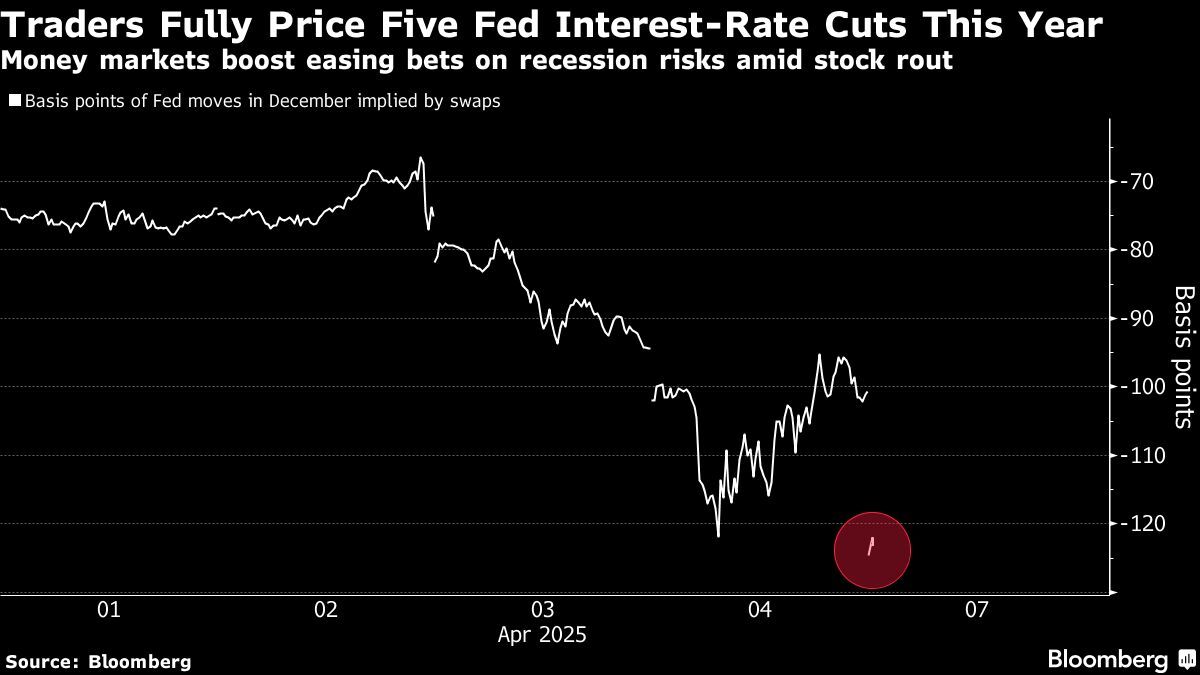
To be sure, US Federal Reserve chair Jerome Powell made clear last Friday that he would not rush to ease rates, even as turmoil erupts across markets. In a speech, he stressed that still-elevated inflation means policymakers will need to act with caution given the temporary price boost from tariffs.
(April 7): Traders boosted expectations for the Federal Reserve (Fed) to cut interest rates this year — and raised the spectre of a reduction before the central bank’s next meeting — as the US administration’s tariffs ignite fears of a global recession.
Markets priced 125 basis points of easing by year end, equivalent to five quarter-point moves, overnight interest-rate swaps showed. While that move later pared, the uptick has been sharp; as of last week, just three reductions were fully priced. Swaps also showed a chance of about 40% that the central bank lowers its benchmark rate 25 basis points by next week, well before the Fed’s next scheduled policy decision on May 7.
The rapid repricing reflects the fear sweeping global markets, with US President Donald Trump showing little appetite to back down on aggressive trade tariffs announced last week. He told reporters on Sunday evening to “forget markets for a second”.
Investors are dumping risk and snapping up bonds, sending yields plummeting. The yield on the US two-year bond, among the most sensitive to monetary policy, fell as much as 22 basis points to 3.43% on Monday, having fallen about 50 basis points in total since Trump announced the levies last Wednesday.
“There is no good news. The markets are getting ugly,” said Michael Brown, a senior research strategist at Pepperstone. “A policy pivot, from either the White House, or the Fed, is what the market craves. Neither, for the time being, seems especially likely, leading to more economic, and market, pain being on the cards.”
Emergency interest-rate cuts are highly unusual and last employed by the Fed as the coronavirus outbreak roiled markets in early 2020. Traders briefly anticipated an inter-meeting in August when stocks fell sharply amid an unwind of the yen carry-trade, but policymakers held firm.
Late last week, open interest in the April fed funds futures soared, with volumes last Thursday ending at a record high. At least one large block trade stands to benefit from a potential Fed policy move before the next scheduled meeting, based on the expiry date of the contract.
German bonds also rallied hard on Monday, sending the German two-year yield down by as much as 20 basis points to just above 1.60%, the lowest since October 2022. Haven currencies including the yen and Swiss franc surged against the dollar.
Recession incoming
In recent days, JPMorgan Chase & Co said it expects the US economy to fall into a recession this year. Chief economist Michael Feroli sees the Fed cutting in June, with moves at each subsequent meeting through January.
Economists at Goldman Sachs Group Inc also changed their forecasts last week, with three reductions now the base case for both the Fed and the European Central Bank (ECB).
Governments around the world are rushing to negotiate with US officials to reduce the tariffs imposed on their exports, leaving markets in freefall as traders price in the uncertainty of whether deals can be struck.
Traders have also slashed rate-cut bets for the ECB and Bank of England on expectations policymakers will have to act to shield their economies. In both cases, swaps now imply three quarter-point cuts with around a 50% chance of a fourth by year end.
To be sure, Fed chair Jerome Powell made clear last Friday that he would not rush to ease rates, even as turmoil erupts across markets. In a speech, he stressed that still-elevated inflation means policymakers will need to act with caution given the temporary price boost from tariffs.
“Don’t expect the Fed to come to the rescue with an emergency rate cut,” said Elias Haddad, a senior market strategist at Brown Brothers Harriman. “This is an entirely policy-driven market meltdown, and there is no reason for the Fed to bail out financial markets.”
Uploaded by Tham Yek Lee
- Global funds hit pause on Indonesia after Prabowo policy changes
- Embattled billionaire Ong Beng Seng to step down from Hotel Properties
- Trump warns tariffs coming for electronics after reprieve
- Jentayu signs 40-year power purchase agreement for RM2.8b 162MW Sabah hydropower project
- Singapore eases monetary policy as expected, sees weaker growth in 2025
- Goldman Sachs warns oil faces ‘large surpluses’ through 2026
- China’s stock rescue in full swing as ETF inflows hit record
- Knight Frank survey indicates optimism for Malaysia’s commercial sector this year
- The State of the Nation: US’ trade deficit-based ‘reciprocal’ tariffs set to test fiscal and monetary policy space
- Thailand finalises US trade strategy ahead of talks next week

